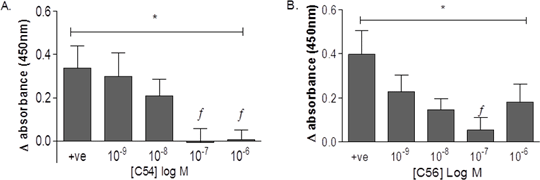Print version
Search Pub Med
ELISA screen of novel compounds that inhibit S100P and RAGE binding to identify new candidate drugs as a new therapy for pancreatic cancer
Introduction: Pancreatic ductal adenocarcinoma (PDAC) is one of the most lethal human cancers with a 5-year survival rate of less than 5%. There is a high prevalence of S100P in PDAC; the calcium-binding protein S100P is highly metastasis-promoting through its extracellular interaction with the receptor for advanced glycation end-products (RAGE). Once bound by S100P, RAGEstimulates pancreatic tumour proliferation, invasion and metastasis progression in vivo. Methods: Using computational chemistry methods, our laboratory has designed inhibitors that prevent RAGE-S100P binding. A total of 86 compounds were synthesized or purchased from a commercial supplierfor screening. Development of an ELISA was based on a published study by (Padillaet al, 2014); 2µM S100P (made using recombinant human S100P plasmid in E.coli) was coated onto 96 well plates, and increasing concentrations of RAGE added to the wells. Cromolyn (10µM), a known inhibitor of S100P-RAGE binding was used as a positive control; after incubation with goat anti human antibody HRP conjugate and activation with tetramethylbenzidine (TMB), RAGE binding was ascertained at 450nm using a multiskan spectrophotometer. All 86 compounds were screened in triplicate, with a further two tests conducted with compounds that indicated inhibitory properties.
Figure 1. ELISA results from two novel compounds A. C54 and B. C56. Wells were coated with S100P protein, incubated with novel compounds and the ability for RAGE to bind determined. Vehicle control treated wells lacked inhibitor (+ve), and background absorbance deducted (S100P, no RAGE). Data are represented as the mean ± SEM, n=9 from 3 separate plates; significance by one-way ANOVA is denoted by *= p<0.05, and Dunnet’sposthoc test f= p<0.05 compared to +ve control
Results: This ELISA screen identified 18 lead compounds (Figure 1); 5 of which have shown anti-proliferative effects in pancreatic cell lines. Conclusions: Results from this project will ultimately lead on to further screens for anti-migratory effects of the novel compounds on pancreatic cancer, and will be used as scaffolds for optimisation and further development of an S100P-RAGE inhibitor. Padilla, L. et al (2014). S100 to receptor for advanced glycation end-products binding assay: Looking for inhibitors. Biochemical and Biophysical Research Communications, 446(1), 404-409. Funded by Worldwide Cancer Research
|



